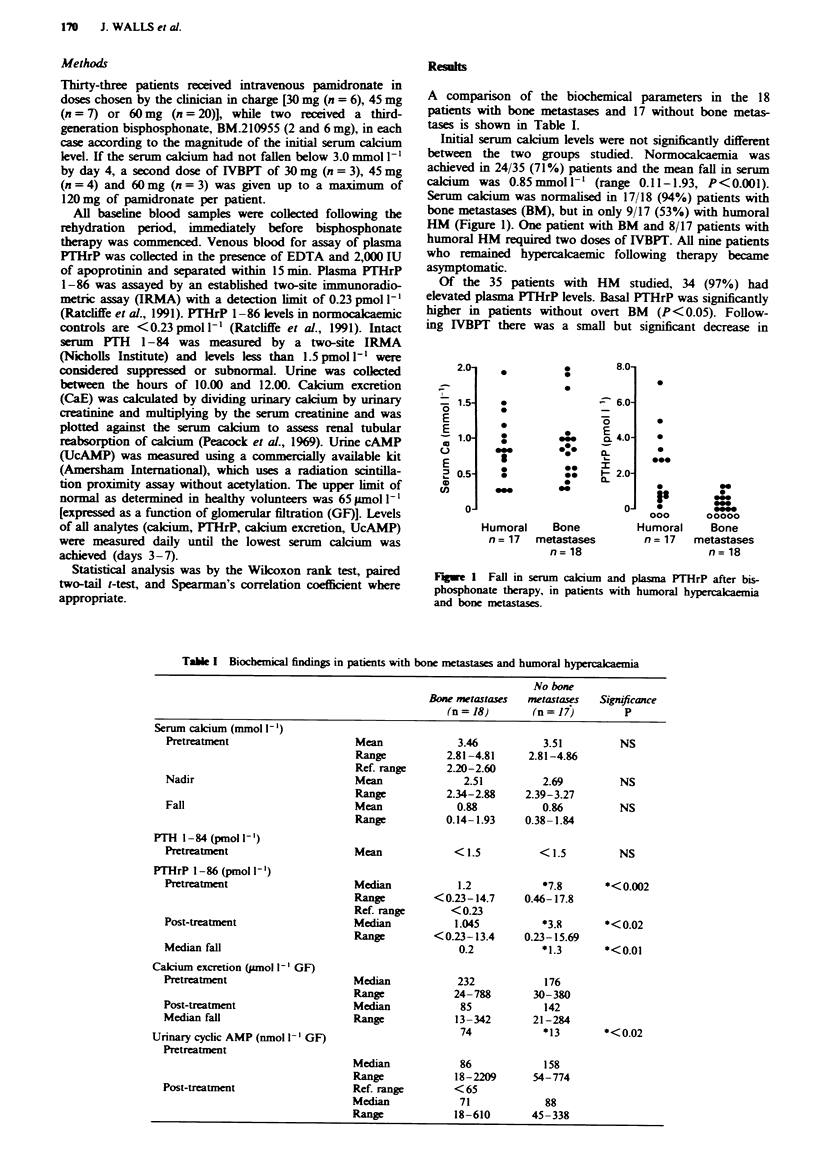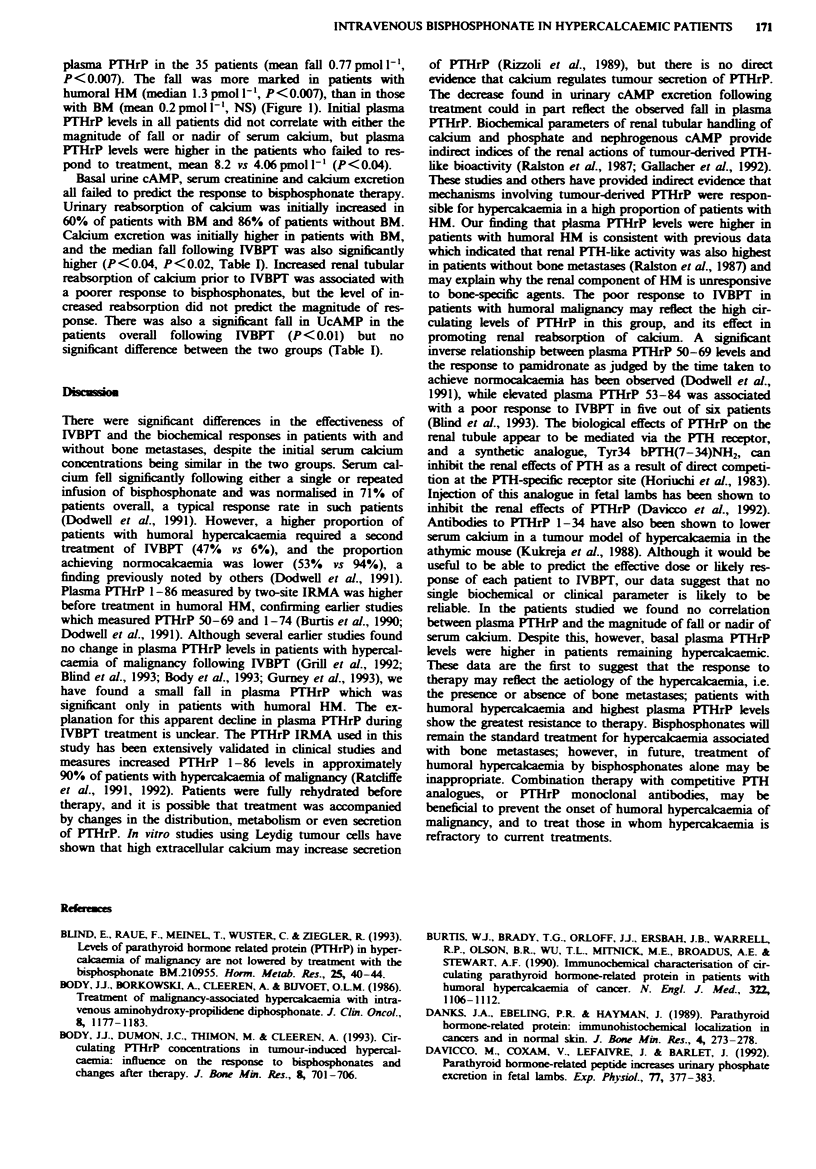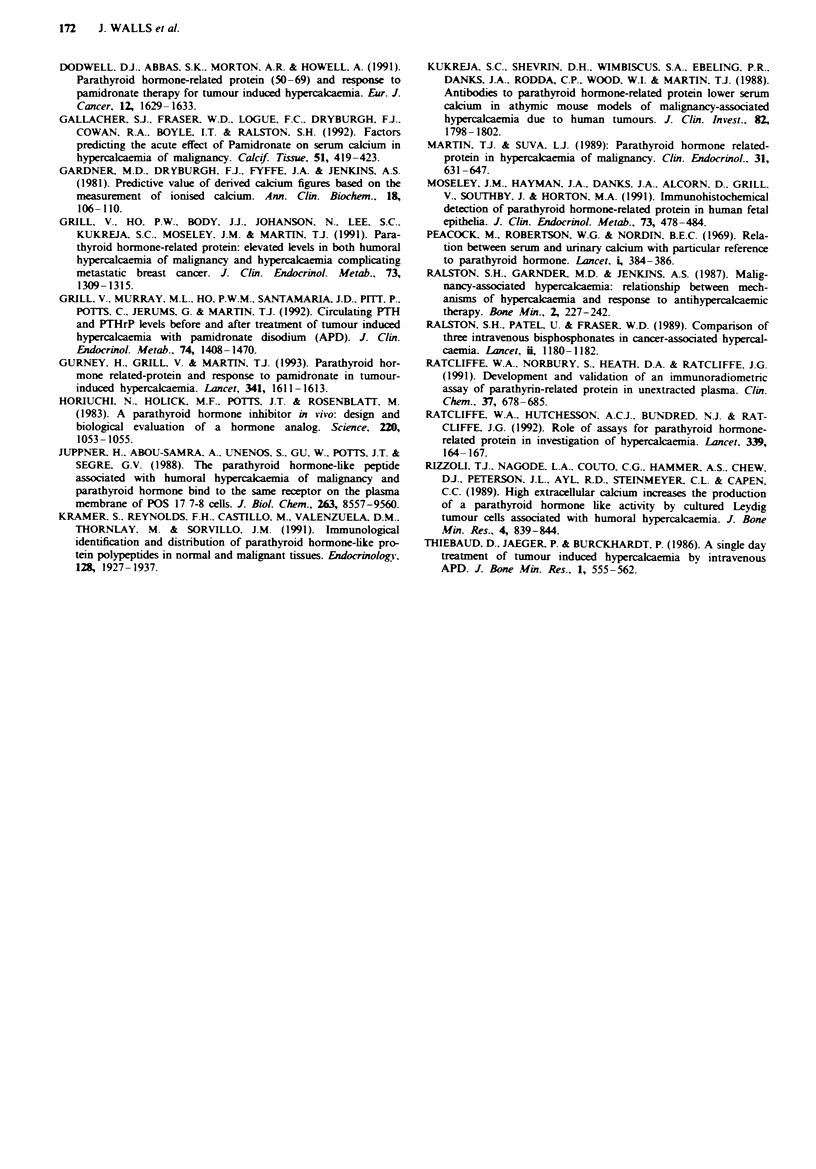Abstract
Plasma parathyroid hormone related-protein (PTHrP) may inhibit the calcium-lowering effect of bisphosphonate therapy. In this prospective study we examined the relationship between plasma PTHrP levels, renal tubular markers of calcium reabsorption, and the effectiveness of intravenous bisphosphonate therapy (IVBPT) in lowering serum calcium in patients with hypercalcaemia of malignancy (HM), with and without bone metastases. Thirty-five symptomatic hypercalcaemic patients (17 without and 18 with bone metastases) were treated with IVBPT (pamidronate 30-60 mg or BM21.0955 2-6 mg). Normocalcaemia was achieved in 24/35 (71%) patients with a mean fall in serum calcium of 0.85 mmol l-1 (range 0.11-1.93, P < 0.001). In the 35 patients studied, serum calcium levels reached a nadir between days 3 and 7, and this was accompanied by a small but significant reduction in plasma PTHrP levels (median reduction 0.77 pmol l-1, P = 0.007). Patients who responded to bisphosphonate therapy by becoming normocalcaemic had significantly lower basal plasma PTHrP levels, mean 4.06 vs 8.2 pmol l-1 (P < 0.04). A significant reduction in urinary calcium excretion was seen (mean 106 mumol l-1, P < 0.02) in patients with bone metastases, and urinary cAMP (mean 170 mmol l-1, P < 0.01) fell in all patients. Patients without demonstrable bone metastases had significantly higher plasma PTHrP levels (P < 0.002), required more doses of IVBPT, and had a poorer reduction in serum calcium compared with patients with bone metastases, only one of whom required more than one dose. We conclude that circulating PTHrP has an important role in increasing renal tubular reabsorption of calcium in HM, thus reducing the effectiveness of bisphosphonate therapy, particularly in patients with humoral HM and no bone metastases.
Full text
PDF



Selected References
These references are in PubMed. This may not be the complete list of references from this article.
- Blind E., Raue F., Meinel T., Wüster C., Ziegler R. Levels of parathyroid hormone-related protein (PTHrP) in hypercalcemia of malignancy are not lowered by treatment with the bisphosphonate BM 21.0955. Horm Metab Res. 1993 Jan;25(1):40–44. doi: 10.1055/s-2007-1002043. [DOI] [PubMed] [Google Scholar]
- Body J. J., Borkowski A., Cleeren A., Bijvoet O. L. Treatment of malignancy-associated hypercalcemia with intravenous aminohydroxypropylidene diphosphonate. J Clin Oncol. 1986 Aug;4(8):1177–1183. doi: 10.1200/JCO.1986.4.8.1177. [DOI] [PubMed] [Google Scholar]
- Body J. J., Dumon J. C., Thirion M., Cleeren A. Circulating PTHrP concentrations in tumor-induced hypercalcemia: influence on the response to bisphosphonate and changes after therapy. J Bone Miner Res. 1993 Jun;8(6):701–706. doi: 10.1002/jbmr.5650080608. [DOI] [PubMed] [Google Scholar]
- Burtis W. J., Brady T. G., Orloff J. J., Ersbak J. B., Warrell R. P., Jr, Olson B. R., Wu T. L., Mitnick M. E., Broadus A. E., Stewart A. F. Immunochemical characterization of circulating parathyroid hormone-related protein in patients with humoral hypercalcemia of cancer. N Engl J Med. 1990 Apr 19;322(16):1106–1112. doi: 10.1056/NEJM199004193221603. [DOI] [PubMed] [Google Scholar]
- Danks J. A., Ebeling P. R., Hayman J., Chou S. T., Moseley J. M., Dunlop J., Kemp B. E., Martin T. J. Parathyroid hormone-related protein: immunohistochemical localization in cancers and in normal skin. J Bone Miner Res. 1989 Apr;4(2):273–278. doi: 10.1002/jbmr.5650040221. [DOI] [PubMed] [Google Scholar]
- Davicco M. J., Coxam V., Lefaivre J., Barlet J. P. Parathyroid hormone-related peptide increases urinary phosphate excretion in fetal lambs. Exp Physiol. 1992 Mar;77(2):377–383. doi: 10.1113/expphysiol.1992.sp003598. [DOI] [PubMed] [Google Scholar]
- Dodwell D. J., Abbas S. K., Morton A. R., Howell A. Parathyroid hormone-related protein(50-69) and response to pamidronate therapy for tumour-induced hypercalcaemia. Eur J Cancer. 1991;27(12):1629–1633. doi: 10.1016/0277-5379(91)90431-c. [DOI] [PubMed] [Google Scholar]
- Gallacher S. J., Fraser W. D., Logue F. C., Dryburgh F. J., Cowan R. A., Boyle I. T., Ralston S. H. Factors predicting the acute effect of pamidronate on serum calcium in hypercalcemia of malignancy. Calcif Tissue Int. 1992 Dec;51(6):419–423. doi: 10.1007/BF00296674. [DOI] [PubMed] [Google Scholar]
- Gardner M. D., Dryburgh F. J., Fyffe J. A., Jenkins A. S. Predictive value of derived calcium figures based on the measurement of ionised calcium. Ann Clin Biochem. 1981 Mar;18(Pt 2):106–109. doi: 10.1177/000456328101800210. [DOI] [PubMed] [Google Scholar]
- Grill V., Ho P., Body J. J., Johanson N., Lee S. C., Kukreja S. C., Moseley J. M., Martin T. J. Parathyroid hormone-related protein: elevated levels in both humoral hypercalcemia of malignancy and hypercalcemia complicating metastatic breast cancer. J Clin Endocrinol Metab. 1991 Dec;73(6):1309–1315. doi: 10.1210/jcem-73-6-1309. [DOI] [PubMed] [Google Scholar]
- Grill V., Murray R. M., Ho P. W., Santamaria J. D., Pitt P., Potts C., Jerums G., Martin T. J. Circulating PTH and PTHrP levels before and after treatment of tumor induced hypercalcemia with Pamidronate Disodium (APD). J Clin Endocrinol Metab. 1992 Jun;74(6):1468–1470. doi: 10.1210/jcem.74.6.1592895. [DOI] [PubMed] [Google Scholar]
- Gurney H., Grill V., Martin T. J. Parathyroid hormone-related protein and response to pamidronate in tumour-induced hypercalcaemia. Lancet. 1993 Jun 26;341(8861):1611–1613. doi: 10.1016/0140-6736(93)90756-7. [DOI] [PubMed] [Google Scholar]
- Horiuchi N., Holick M. F., Potts J. T., Jr, Rosenblatt M. A parathyroid hormone inhibitor in vivo: design and biological evaluation of a hormone analog. Science. 1983 Jun 3;220(4601):1053–1055. doi: 10.1126/science.6302844. [DOI] [PubMed] [Google Scholar]
- Jüppner H., Abou-Samra A. B., Uneno S., Gu W. X., Potts J. T., Jr, Segre G. V. The parathyroid hormone-like peptide associated with humoral hypercalcemia of malignancy and parathyroid hormone bind to the same receptor on the plasma membrane of ROS 17/2.8 cells. J Biol Chem. 1988 Jun 25;263(18):8557–8560. [PubMed] [Google Scholar]
- Kramer S., Reynolds F. H., Jr, Castillo M., Valenzuela D. M., Thorikay M., Sorvillo J. M. Immunological identification and distribution of parathyroid hormone-like protein polypeptides in normal and malignant tissues. Endocrinology. 1991 Apr;128(4):1927–1937. doi: 10.1210/endo-128-4-1927. [DOI] [PubMed] [Google Scholar]
- Kukreja S. C., Shevrin D. H., Wimbiscus S. A., Ebeling P. R., Danks J. A., Rodda C. P., Wood W. I., Martin T. J. Antibodies to parathyroid hormone-related protein lower serum calcium in athymic mouse models of malignancy-associated hypercalcemia due to human tumors. J Clin Invest. 1988 Nov;82(5):1798–1802. doi: 10.1172/JCI113794. [DOI] [PMC free article] [PubMed] [Google Scholar]
- Martin T. J., Suva L. J. Parathyroid hormone-related protein in hypercalcaemia of malignancy. Clin Endocrinol (Oxf) 1989 Nov;31(5):631–647. doi: 10.1111/j.1365-2265.1989.tb01288.x. [DOI] [PubMed] [Google Scholar]
- Moseley J. M., Hayman J. A., Danks J. A., Alcorn D., Grill V., Southby J., Horton M. A. Immunohistochemical detection of parathyroid hormone-related protein in human fetal epithelia. J Clin Endocrinol Metab. 1991 Sep;73(3):478–484. doi: 10.1210/jcem-73-3-478. [DOI] [PubMed] [Google Scholar]
- Peacock M., Robertson W. G., Nordin B. E. Relation between serum and urinary calcium with particular reference to parathyroid activity. Lancet. 1969 Feb 22;1(7591):384–386. doi: 10.1016/s0140-6736(69)91353-1. [DOI] [PubMed] [Google Scholar]
- Ralston S. H., Gallacher S. J., Patel U., Dryburgh F. J., Fraser W. D., Cowan R. A., Boyle I. T. Comparison of three intravenous bisphosphonates in cancer-associated hypercalcaemia. Lancet. 1989 Nov 18;2(8673):1180–1182. doi: 10.1016/s0140-6736(89)91791-1. [DOI] [PubMed] [Google Scholar]
- Ralston S. H., Gardner M. D., Jenkins A. S., McKillop J. H., Boyle I. T. Malignancy-associated hypercalcaemia: relationship between mechanisms of hypercalcaemia and response to antihypercalcaemic therapy. Bone Miner. 1987 May;2(3):227–242. [PubMed] [Google Scholar]
- Ratcliffe W. A., Hutchesson A. C., Bundred N. J., Ratcliffe J. G. Role of assays for parathyroid-hormone-related protein in investigation of hypercalcaemia. Lancet. 1992 Jan 18;339(8786):164–167. doi: 10.1016/0140-6736(92)90220-w. [DOI] [PubMed] [Google Scholar]
- Ratcliffe W. A., Norbury S., Heath D. A., Ratcliffe J. G. Development and validation of an immunoradiometric assay of parathyrin-related protein in unextracted plasma. Clin Chem. 1991 May;37(5):678–685. [PubMed] [Google Scholar]
- Thiébaud D., Jaeger P., Jacquet A. F., Burckhardt P. A single-day treatment of tumor-induced hypercalcemia by intravenous amino-hydroxypropylidene bisphosphonate. J Bone Miner Res. 1986 Dec;1(6):555–562. doi: 10.1002/jbmr.5650010610. [DOI] [PubMed] [Google Scholar]


